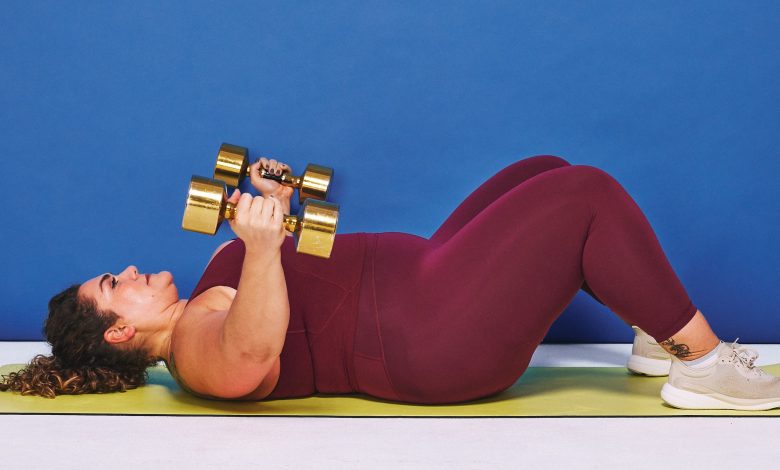This Beginner-Friendly Chest Workout Will Strengthen Your Upper Body

Whether you’re carrying a bag of dog food, walking with a stroller, or pushing open a heavy door, there are tons of instances when a beginner chest workout can really come in clutch, giving you the strength you need to crush those tasks of daily life. And we have just the routine to help bolster your upper body: A five-move dumbbell chest workout you can do right at home.
Now, the best chest workouts (and the best chest exercises in general) don’t just hone in on your pectoral (pec) muscles alone—they also smoke your arms and shoulders too. That’s because one of the main jobs of your chest is to perform that pushing motion. And to do that most efficiently, you need to recruit the supporting muscle groups, including your triceps (back of your upper arms) and deltoids (shoulders), to get the job done. The stronger all these muscles are, the more effectively you’ll be able to push.
That’s the idea behind the beginner chest workout below. Developed by Asher Freeman, CPT, creator of the Nonnormative Body Club in Philadelphia, the routine includes five exercises to smoke those upper-body muscles. First there’s the chest press. This quintessential chest exercise is similar to the bench press, except you’re using dumbbells instead of a barbell and are on the floor instead of a bench. It’s a classic for a reason: It hits all the players you need to complete pushing motions, including the pecs (both the bigger pectoralis major and the smaller pectoralis minor), deltoids, and triceps, Freeman explains.
Then there’s the overhead press, another push move that really targets your deltoids and triceps and translates over to so many tasks of daily life, like putting dishes away on a high shelf or hoisting your suitcase into the overhead bin. After that, there’s the pec dumbbell fly, which works your chest muscles from a different angle through the transverse plane of motion (which includes all rotational exercises). This helps build well-rounded strength when paired with moves like the chest press (which has you working in the sagittal plane, or forward and backward movement) and lateral raise (which involves side-to-side moves, in the frontal plane).
Speaking of, the lateral raise and triceps kickback round out the workout. Now, these don’t hit the pectorals directly, but “our shoulders and our arms assist our pecs whenever we’re pushing, so being able to strengthen them independently also can be advantageous,” Freeman says.
Quick caveat: If you’re new to resistance training in general, Freeman suggests starting with two to three total-body sessions per week, which means you wouldn’t slot in a chest day-specific routine like this into your workout plan. With that approach, they explain, you can build the habit without burning out and overtraining. Once you’ve gotten comfortable with that cadence and are ready for more gym sessions (or home workouts!), you could do this chest one. It’s a good beginner chest workout because it uses dumbbells (which are more newbie-friendly than barbells) and is packed with classic, foundational exercises you can progress over time.
Do it as a stand-alone routine if you really want to strengthen your chest. Or you can tack it on to leg and glute-focused exercises, like squats and hinges, to make it more of a full-body workout. Just make sure you’re also incorporating pulling exercises into your overall program to hit your back muscles, including your lats, so that you avoid creating or exacerbating muscle imbalances.
No matter how you slot this sequence into your routine, it’s sure to fire up your chest, arm, and shoulder muscles and improve your all-important pushing abilities. Here’s all you need to know to give it a whirl!
The Workout
What you need: Three sets of dumbbells. A heavy pair for the chest press, a medium pair for the overhead press, and a light pair for the pec fly, lateral raise, and triceps kickback. The right weight will depend on your current strength level and familiarity with these exercises, but as a general rule of thumb, aim to use weights that feel challenging but doable to complete the prescribed rep count with. If you can do more than 15 reps of a given exercise with good form, then that’s a sign to bump up your weight.
Exercises
- Chest Press
- Overhead Press
- Pec Fly
- Lateral Raise
- Triceps Kickback
Directions
- Do the following moves in the order listed below. For each, do two sets of 10–15 reps, resting at least 30 to 60 seconds after each set.
- Once you’ve completed two sets of an exercise, move onto the next exercise on the list.
-
Katie Thompson
Chest Press
- Lie face up with your knees bent and feet flat on the floor. Hold a weight in each hand with your palms facing each other and your elbows on the floor bent so that the weights are in the air. This is the starting position.
- Press the weights toward the ceiling, straightening your elbows completely and keeping your palms facing each other. Pause here for a second.
- Slowly bend your elbows and lower them back down to the floor and out so that they are perpendicular to your torso. This is 1 rep.
- Do 10-15 reps.
A classic pushing exercise that’s a more beginner-friendly version of the barbell bench press, the chest press works your pectoral muscles (including your upper chest and lower chest muscles), triceps, and front and side deltoids, Freeman says. As an alternate bodyweight option, do incline push-ups instead. Compared to regular push-ups, incline ones are easier since elevating your hands helps reduce the amount of bodyweight you’re pushing. (By contrast, decline push-ups, where you raise your feet, would be more intense.)
-
Katie Thompson
Overhead Press
- Stand with your feet about hip-width apart. Hold a dumbbell in each hand at your shoulders with your palms facing forward and your elbows bent. This is the starting position.
- Press the dumbbells overhead, straightening your elbows completely. Make sure to keep your core engaged and hips tucked to avoid arching your lower back as you lift your arms.
- Slowly bend your elbows to lower the weight back down to the starting position. This is 1 rep.
- Do 10-15 reps.
Your deltoids and triceps are the main lifters here. Do the move with your palms facing forward (as shown) or palms facing each other in a neutral grip—play with both options and choose the one that feels better for your shoulders, Freeman recommends. Also, if you’re new to this exercise or struggling to stabilize as you hoist the weights overhead, perform it sitting down: This can help you really zero in on your upper body, rather than using your legs for momentum or extending your back as you press the weights up—two common form mistakes Freeman sees when people do this move standing.
-
Katie Thompson
Pec Fly
- Lie faceup on an exercise mat, with your feet flat on the floor and knees bent. Hold a dumbbell in both hands directly above your chest, palms facing in. This is the starting position.
- Slowly lower the weights down to the floor, holding your arms in an arc (as if you were hugging a tree), until the backs of your upper arms hit the floor, or as far as your shoulder mobility allows.
- Maintaining that arc, return your arms back to starting position. This is 1 rep.
- Do 10-15 reps.
This move really targets your pecs. As you lower the weights down, go slow and make sure you maintain control of them, Freeman says. You don’t want the weights to stretch your shoulders beyond their normal range of motion. If you feel discomfort at the bottom of the move, that’s a sign you may have lowered too far. Another tip: If you have access to resistance bands or a cable machine, Freeman recommends performing the move with those instead, since they provide more consistent resistance throughout the entire exercise compared to dumbbells.
-
Katie Thompson
Lateral Raise
- Stand with your feet about hip-width apart, a dumbbell in each hand, arms resting along the front of your legs, palms facing your legs. This is the starting position. (You can also do this from a seated position with feet pressed firmly into the ground.)
- Think about bringing the weights as far away from each other as possible and raise the weights out to your sides to shoulder level. Don’t raise them any higher than shoulder level, as that will recruit other muscles that are not intended to be working here.
- Lower them back to the starting position. This is 1 rep.
- Do 10-15 reps.
Here you’re primarily working your lateral deltoids, as well as a little bit of your front and rear delts, Freeman says. As you raise the weights, keep your shoulders pulled down away from your ears. Performing the move in front of a mirror can help you keep an eye on this, they add. If you can’t bring your arms to shoulder level without raising your shoulders up, then swap for a lighter weight.
-
Katie Thompson
Triceps Kickback
- Bend your knees and hinge forward at the hips, keeping your core tight and back flat.
- Hold your arms at your sides, with a dumbbell in each hand, palms facing each other.
- Bend at the elbows until your forearms are parallel to the ground, keeping your elbows tight by your rib cage.
- Kick the weights back to completely straighten your arms.
- Bend your arms to return to the starting position. This is 1 rep.
- Do 10-15 reps
This exercise is all about your triceps. No, they’re not a chest muscle, but they’re still important to strengthen since they assist with pushing motions. Keep your elbow tight to your side slides so only your forearms are moving.
Demoing the moves above are Billy Anslow-O’Rourke (GIF 1), doctor of physical therapy and Queens-based group fitness instructor; Robyn Warren (GIF 2), a health educator and the founder of Geek Girl Strong; Morit Summers (GIF 3), a Brooklyn-based trainer and the owner of body-positive gym, Form Fitness Brooklyn; Alicia Jamison (GIF 4), senior coach at Body Space Fitness and adjunct lecturer at Brooklyn College; and Cookie Janee (GIF 5), a background investigator and security forces specialist in the Air Force Reserve.
Related:



